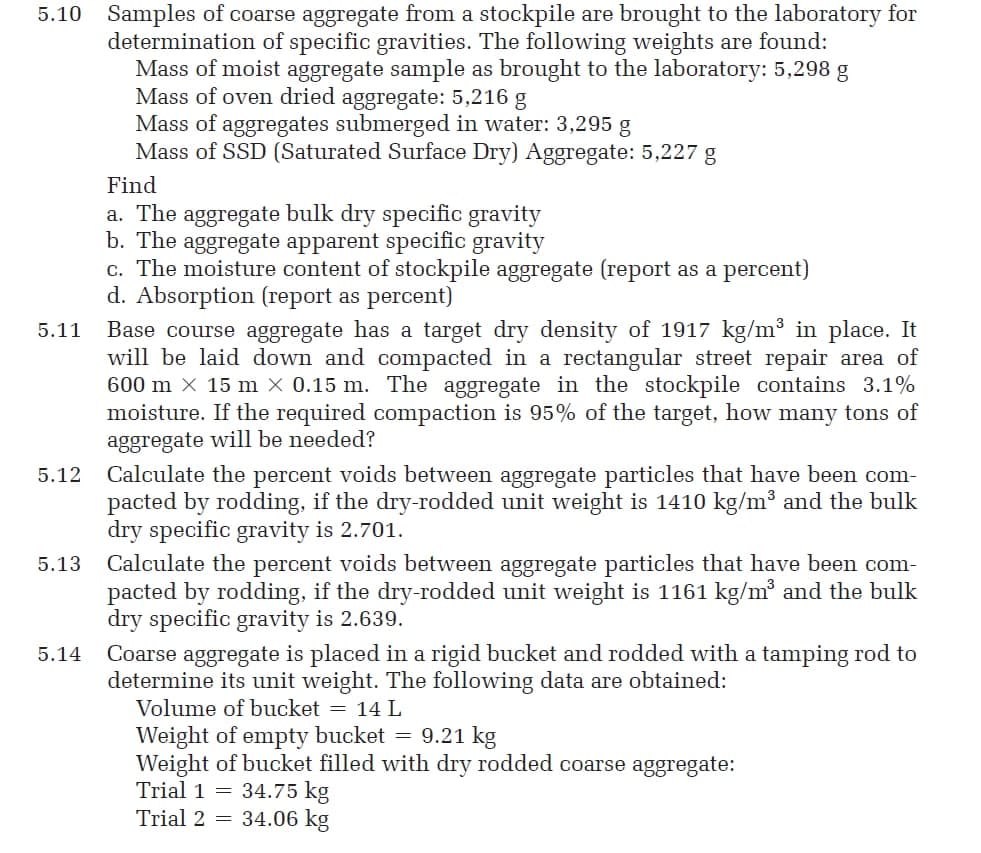5.10 Samples of coarse aggregate from a stockpile are brought to the laboratory for determination of specific gravities. The following weights are found: Mass of moist aggregate sample as brought to the laboratory: 5,298 g Mass of oven dried aggregate: 5,216 g Mass of aggregates submerged in water: 3,295 g Mass of SSD (Saturated Surface Dry) Aggregate: 5,227 g 5.11 5.12 5.13 5.14 Find a. The aggregate bulk dry specific gravity b. The aggregate apparent specific gravity c. The moisture content of stockpile aggregate (report as a percent) d. Absorption (report as percent) Base course aggregate has a target dry density of 1917 kg/m³ in place. It will be laid down and compacted in a rectangular street repair area of 600 m X 15 m X 0.15 m. The aggregate in the stockpile contains 3.1% moisture. If the required compaction is 95% of the target, how many tons of aggregate will be needed? Calculate the percent voids between aggregate particles that have been com- pacted by rodding, if the dry-rodded unit weight is 1410 kg/m³ and the bulk dry specific gravity is 2.701. Calculate the percent voids between aggregate particles that have been com- pacted by rodding, if the dry-rodded unit weight is 1161 kg/m³ and the bulk dry specific gravity is 2.639. Coarse aggregate is placed in a rigid bucket and rodded with a tamping rod to determine its unit weight. The following data are obtained: Volume of bucket = 14 L Weight of empty bucket = 9.21 kg Weight of bucket filled with dry rodded coarse aggregate: Trial 1 = 34.75 kg Trial 2 = 34.06 kg
5.10 Samples of coarse aggregate from a stockpile are brought to the laboratory for determination of specific gravities. The following weights are found: Mass of moist aggregate sample as brought to the laboratory: 5,298 g Mass of oven dried aggregate: 5,216 g Mass of aggregates submerged in water: 3,295 g Mass of SSD (Saturated Surface Dry) Aggregate: 5,227 g 5.11 5.12 5.13 5.14 Find a. The aggregate bulk dry specific gravity b. The aggregate apparent specific gravity c. The moisture content of stockpile aggregate (report as a percent) d. Absorption (report as percent) Base course aggregate has a target dry density of 1917 kg/m³ in place. It will be laid down and compacted in a rectangular street repair area of 600 m X 15 m X 0.15 m. The aggregate in the stockpile contains 3.1% moisture. If the required compaction is 95% of the target, how many tons of aggregate will be needed? Calculate the percent voids between aggregate particles that have been com- pacted by rodding, if the dry-rodded unit weight is 1410 kg/m³ and the bulk dry specific gravity is 2.701. Calculate the percent voids between aggregate particles that have been com- pacted by rodding, if the dry-rodded unit weight is 1161 kg/m³ and the bulk dry specific gravity is 2.639. Coarse aggregate is placed in a rigid bucket and rodded with a tamping rod to determine its unit weight. The following data are obtained: Volume of bucket = 14 L Weight of empty bucket = 9.21 kg Weight of bucket filled with dry rodded coarse aggregate: Trial 1 = 34.75 kg Trial 2 = 34.06 kg
Chapter2: Loads On Structures
Section: Chapter Questions
Problem 1P
Related questions
Question

Transcribed Image Text:5.10 Samples of coarse aggregate from a stockpile are brought to the laboratory for
determination of specific gravities. The following weights are found:
Mass of moist aggregate sample as brought to the laboratory: 5,298 g
Mass of oven dried aggregate: 5,216 g
5.11
5.12
5.13
5.14
Mass of aggregates submerged in water: 3,295 g
Mass of SSD (Saturated Surface Dry) Aggregate: 5,227 g
Find
a. The aggregate bulk dry specific gravity
b. The aggregate apparent specific gravity
c. The moisture content of stockpile aggregate (report as a percent)
d. Absorption (report as percent)
Base course aggregate has a target dry density of 1917 kg/m³ in place. It
will be laid down and compacted in a rectangular street repair area of
600 m × 15 m × 0.15 m. The aggregate in the stockpile contains 3.1%
moisture. If the required compaction is 95% of the target, how many tons of
aggregate will be needed?
Calculate the percent voids between aggregate particles that have been com-
pacted by rodding, if the dry-rodded unit weight is 1410 kg/m³ and the bulk
dry specific gravity is 2.701.
Calculate the percent voids between aggregate particles that have been com-
pacted by rodding, if the dry-rodded unit weight is 1161 kg/m³ and the bulk
dry specific gravity is 2.639.
Coarse aggregate is placed in a rigid bucket and rodded with a tamping rod to
determine its unit weight. The following data are obtained:
Volume of bucket = 14 L
Weight of empty bucket = 9.21 kg
Weight of bucket filled with dry rodded coarse aggregate:
Trial 1 = 34.75 kg
Trial 2 = 34.06 kg
Expert Solution
This question has been solved!
Explore an expertly crafted, step-by-step solution for a thorough understanding of key concepts.
Step by step
Solved in 3 steps

Knowledge Booster
Learn more about
Need a deep-dive on the concept behind this application? Look no further. Learn more about this topic, civil-engineering and related others by exploring similar questions and additional content below.Recommended textbooks for you


Structural Analysis (10th Edition)
Civil Engineering
ISBN:
9780134610672
Author:
Russell C. Hibbeler
Publisher:
PEARSON

Principles of Foundation Engineering (MindTap Cou…
Civil Engineering
ISBN:
9781337705028
Author:
Braja M. Das, Nagaratnam Sivakugan
Publisher:
Cengage Learning


Structural Analysis (10th Edition)
Civil Engineering
ISBN:
9780134610672
Author:
Russell C. Hibbeler
Publisher:
PEARSON

Principles of Foundation Engineering (MindTap Cou…
Civil Engineering
ISBN:
9781337705028
Author:
Braja M. Das, Nagaratnam Sivakugan
Publisher:
Cengage Learning

Fundamentals of Structural Analysis
Civil Engineering
ISBN:
9780073398006
Author:
Kenneth M. Leet Emeritus, Chia-Ming Uang, Joel Lanning
Publisher:
McGraw-Hill Education


Traffic and Highway Engineering
Civil Engineering
ISBN:
9781305156241
Author:
Garber, Nicholas J.
Publisher:
Cengage Learning